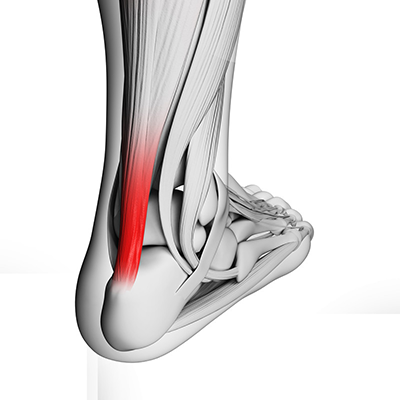Achilles tendinopathy used to be known as Achilles tendonitis or Achilles tendinitis. In general, ‘itis’ usually refers to inflammation, so tendonitis would mean inflammation of a tendon. However, Achilles tendinopathy is now thought to be a better term to use because it is thought that there is little or no inflammation that causes the problem. The Achilles tendon does not have good blood or nerve supply and so can be slow to heal. The tendon receives nutrients from the tendon sheath or paratendon. When an injury occurs to the tendon, cells from surrounding structures migrate into the tendon to assist in repair. Some of these cells come from blood vessels that enter the tendon to provide direct blood flow to increase healing. With the blood vessels come nerve fibres. Researchers, including Alfredson et al. (2003), believe these nerve fibres to be the cause of the pain.

Many studies have investigated the effect of shockwave (SWT) in Achilles tendinopathy, and most reported favourable results (Rompe et al, 2007, Rompe et al, 2008, Rompe et al, 2009, Costa et al, 2005, Rasmussen et al, 2008).
Evidence from meta-analysis of data from two studies comparing shockwave to eccentric exercise found no significant effects for outcomes of pain and function at 16 weeks (Rompe et al, 2007, Rompe et al, 2008). One of these studied insertional AT (Rompe et al, 2008) while the other studied midportion AT (Rompe et al, 2007). However the 2007 study by Rompe et al. also included a wait-and-see group, allowing comparisons to be made between SWT and a no-treatment control. Moderately significant effects were found that favoured SWT at 16 weeks.
Hart (2009) did a comparative study between eccentric exercise and ESWT for chronic Achilles tendinopathy and showed better results with ESWT.
In a later study Rompe et al. (2009) examined the effects of SWT when added to eccentric exercise. This combination showed moderate to significant effects favouring combined SWT and eccentric exercise over eccentric exercise alone after 16 weeks.
Two studies (Costa et al, 2005 and Rasmussen et al, 2008) evaluated SWT using double-blind, placebo-controlled study designs. Costa et al. (2005) compared SWT directly to application of sham SWT over 12 weeks. There were no significant pain effects favouring either SWT or sham SWT at 12 week follow-up. Although their findings were not statistically significant, the authors acknowledge that “the confidence intervals include the potential for a clinically relevant treatment effect.” This raises the possibility of type II error, that is, the sample size was too small to detect a meaningful treatment effect.
Rasmussen et al. (2008) investigated differences between SWT and sham SWT as an addition to a conservative therapy program that included eccentric exercise. After four weeks of intervention, no statistically significant effects were found for either group. They used the American Orthopaedic Foot and Ankle Society (AOFAS) score and pain for evaluation. Patients were followed up at 4, 8, and 12 weeks. AOFAS increased more over time in the intervention group than in the control, from 74 to 81 in the placebo group compared to 70 to 88 in the intervention group. Better results were seen in the intervention group at 8 and 12 weeks follow-up. Pain was reduced in both groups but no statistically significant difference was noted. Interestingly, women showed the best outcome, an unexpected finding. The authors concluded that ESWT appears to be a supplement for the treatment of chronic Achilles tendinopathy
Sussmilch-Leitch et al (2012) said shockwave appears more efficacious than no treatment (agreeing with Rompe et al, 2007), but suggested a placebo effect associated with pain and function outcomes. But they did recommend shockwave be used in conjunction with eccentric exercise at the Achilles tendon because together patients had better outcomes.
In a recent article looking at the available literature Al-Abbad and Simon (2013) found although there were common methodological deficiencies in the studies done so far, there was consistent evidence on the effectiveness of ESWT in the management of patients with chronic Achilles tendinopathies at a minimum of 3 months follow-up. They concluded that overall there was satisfactory evidence for the effectiveness of low-energy ESWT in the treatment of chronic insertional and non-insertional Achilles tendinopathies at a minimum of 3 months follow-up. They went further and said ESWT should be considered before surgery if other conservative management fails. However, combining ESWT with eccentric loading appears to show superior results.
Mani-Babu et al. (2015) in a large systematic review concluded that there was moderate evidence indicating that ESWT is more effective than eccentric loading for insertional Achilles tendinopathy and that ESWT was equal to eccentric loading for midportion Achilles tendinopathy in the short term. Additionally, there is moderate evidence that combining ESWT and eccentric loading in midportion AT may produce superior outcomes to eccentric loading alone. They finished by stating that extracorporeal shock wave therapy is an effective intervention and should be considered for Achilles tendinopathy particularly when other non-operative treatments have failed.
It appears that the most popular method for treating Achilles tendinopathy is to use low energy (0.08mj/mm2 is most popular) at low frequency. However this seems to also offer the lowest results. Higher energy levels appear to offer better outcomes. Many clinicians believe at least 0.12mj/mm2 is required and some even more.
Settings: Anywhere up to 0.5mj/mm2, 5.0 bar or 185mj can be used depending on tolerance of pain. Normally 10hz for 2000 shocks.
Frequency: Repeated every 5-7 days. Sessions as required to eliminate the pain. In the studies above 3-4 is the most common number.